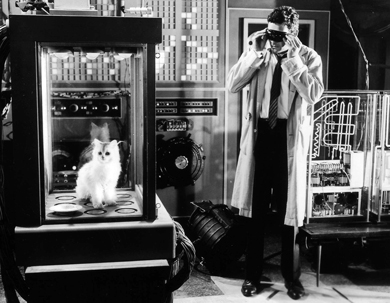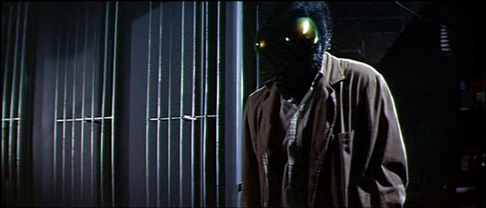Reviewed by Glenn Erickson
Although cheaply made independent monster movies about mutated bugs had already been packing the drive-ins for a couple of summers, it wasn't until 1958 that the major studios stepped in looking for easy pickings. Paramount hired William Alland away from Universal to produce The Space Children and Colossus of New York, and made a killing by distributing Jack H. Harris's chiller The Blob. Independent producer Robert L. Lippert made several science fiction thrillers for 20th Fox release (such as She-Devil) under the Regal Films banner. His box office hit The Fly originated with a 1957 short story by George Langelaan, first published in Playboy. The writer probably found his inspiration the moment he heard an explanation of the workings of television. If images can be broadcast from one location to another, why not objects? Langelaan's disturbing story was an obvious choice for the big screen. Presented in color and stereophonic sound, The Fly was promoted with mysterious ads promising horrors unknown. The genuinely icky concept definitely had legs: Fox followed it up with two cheap sequels. David Cronenberg's remake 28 years later is a minor masterpiece that expands on the original's concept. Although given third billing, the real star on view is Vincent Price. His sincere and committed performance lends credibility to the fantastic story concept.

The Fly nests an imaginative science fiction thriller within a romantic 'woman's picture' format. Audiences were surprised and shocked by the film's horror aspects. Like a technological cousin of Kafka's cockroach freak in Metamorphosis, a man suddenly finds himself possessing the head of a giant insect. As his grim fate is known early on, his wife's hopeful optimism provides a tension of its own.
The setting is a home in Montreal, where a murder confession is played out in flashbacks. Brilliant researcher Andre Delambre (Al "David" Hedison) is found with his head crushed in a machine press, and Inspector Charas (Herbert Marshall) discovers his widow Helene (Patricia Owens) in a state of confused denial. Andre's businessman brother François (Vincent Price) knows that Helene is lying about what really happened, and tricks her into a full explanation. Andre had invented an amazing matter transmitter and was teleporting objects from one booth to another in his basement lab. Then he foolishly tried to teleport himself...
Producer Lippert may have been drawn to the project because of similarities to the English The Quatermass Xperiment, on which he had also served as an uncredited producer. Both films concern sympathetic men transformed against their will into horrible monsters. Andre Delambre emerges from the teleportation booth with the head and claw of a fly, while somewhere in the house buzzes a confused fly with Andre's head and hand. Sympathy for the understandably distraught Helene creates interest for a concept that by all rights should be plain silly, especially when the tiny fly, caught in a spider's web, squeals "Help me!" The moment may be funny, but it can't be forgotten. The nightmarish, agonized face in the web never goes away.

Director Kurt Neumann's straightforward storytelling disguises some of The Fly's lapses of logic. The malfunctioning matter transmitter makes radically inconsistent errors with each use. After the dematerialized cat fails to re-materialize in the second booth, Andre can hear it meeyowing, like a ghost. 1 We also wonder how the fly head got bigger and Andre's head was made smaller. It still appears to be Andre's brain in there, at least until he tells Helene that he's losing his will to that of the fly. Andre one point confesses that he's not sure how parts of his own machine function, and doesn't understand why some teleportations are successful and others are not. Yet he's willing to use himself as a human guinea pig?
The Fly updates the creaky concept of the filmic Mad Scientist. Andre is a workaholic but also a loving husband. He works not in an isolated castle but in a tidy industrial space in the basement of his fashionable house, while his brother handles the business end of things. Instead of providing an additional menace, Vincent Price's François encourages Andre to keep working on his "flat television screen" idea. Just the same, the script opts for the easy way out. Instead of sending Andre back to engineering school, it proclaims that he meddled with things Man was not meant to know. François Delambre tells little Phillipe that his father was a lot like Columbus, an explorer in the unknown. Writer Richard Hodgens points out that, "what will be remembered is that Father was like a fly." 2

Andre Delambre's ordeal has contributed several unforgettable images to Sci-fi's gallery of greatness. The teleportations are orchestrated with a buildup of flashing lights and screeching noise. Witnesses wear dark goggles, as if watching a nuclear blast. The reveal of Andre's frightening fly's head is quite a shock, as is his compound eye POV of his wife's reaction, a pattern of dozens of screaming Helenes. The head-crushing business with the machine press accounts for more horror trauma and final scene at the spider's web is justly famous. Vincent Price, Patricia Owens and Herbert Marshall manage to pull off their unlikely scenes by taking everything seriously. The Fly earned a reputation as a shocker with a number of big scares.
Thirty years later David Cronenberg found the concept of matter transmission a perfect vessel to express his personal themes of biological dysfunction and alienation from the human flesh. Cronenberg's disgusting biological takeover spins off into horrid revelations about gene splicing. But the show that best taps into the moral and philosophical basis of a Delambre-style matter transmitter is 1990's ten-minute Film Board of Canada short subject To Be. Does the machine really send matter through the air like a radio signal, or is it merely transmitting a coded blueprint analysis of the subject, to be reinterpreted and synthesized anew? Is the original simply destroyed, and the 'teleported' object a new duplicate?
20th Century Fox Studio Classics' Blu-ray of The Fly reflects a major film restoration done a couple of years back. The image is rich and colorful, with bright reds and blues. Earlier disc releases have looked good but not nearly as striking as this. The show hasn't many close-ups, indicating that the earlier, less perfect CinemaScope lenses were still in use. Some shots of Patricia Owens still show a touch of the "CinemaScope mumps".
Unlike some features of the 1950s, The Fly survived with its original 4-track stereo audio intact. The movie exercises its classy CinemaScope and color by having Helene and Andre briefly visit the ballet. But the show also includes a color, 'Scope close-up of a dirty trash can, complete with buzzing flies in stereophonic sound. The stereo audio is mixed with the vintage directional method, which pans voices from speaker to speaker instead of leaving them in screen center. Paul Sawtell's soundtrack score makes a strong stereophonic statement.
The disc carries over some of the extras from a Fox DVD set from 2007. Collector and talent agent David Del Valle hosts a commentary with actor David Hedison. Del Valle adds his personal recollections of Vincent Price, and even offers an imitation of the actor's voice. Probing his memory of the filming, Hedison wishes that his transformation into the fly-monster had happened more slowly, which might have enabled him to perform more of a Jekyll-Hyde transformation.
Also repeated is an excellent 1997 Biography episode on Vincent Price, that has appeared on more than one earlier Fox release. It presents clips from a wide range of the actor's work, not just Fox films. The okay featurette Fly Trap: Catching a Classic recaps what we learn by watching the films, with comments by David Del Valle, Steve Haberman and Don Glut. A Fox news film clip and an original trailer round out the package.
It's probably too much to ask Fox to release the sequels Return of the Fly and The Curse of the Fly, as they're both in B&W. But we at DVD Savant are known for positive thinking.
On a scale of Excellent, Good, Fair, and Poor,
The Fly Blu-ray rates:
Movie: Very Good
Video: Excellent
Sound: Excellent
Audio: English 4.0, Spanish and French mono
Supplements: see above
Deaf and Hearing Impaired Friendly?
YES; Subtitles: English, Spanish
Packaging: Keep case
Reviewed: September 13, 2013
Footnotes:
1. The original short story also has Dandelo the cat get lost in limbo, only to make an unwelcome return. When the desperate Andre goes through the transmitter a second time in hopes of un-grafting himself from the fly, he comes out a real mess, with cat features mixed in with the fly characteristics. And the %$@&#! transmitter isn't even on warranty. In the film, Dandelo's atoms might appear at any time. When Andre and Helene teleport a magnum of champagne, one half hopes for Dandelo to show up crammed into the bottle, like a cat in a Warner Bros. cartoon.
Return
2. Hodgens, Richard Film Quarterly 13, no.2 1959.
Return

DVD Savant Text © Copyright 2013 Glenn Erickson
See more exclusive reviews on the Savant Main Page.
Reviews on the Savant main site have additional credits information and are often updated and annotated with reader input and graphics.
Also, don't forget the
2011 Savant Wish List.
T'was Ever Thus.
Return to Top of Page
|


